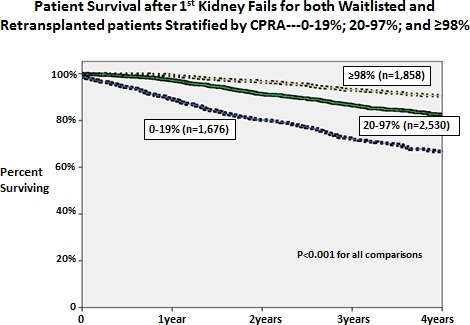What Can UNOS Data Tell Us About Patient Outcomes After Primary Renal Allograft Failure?
1Surgery, Thomas Jefferson University, Philadelphia, PA
2Medicine, Thomas Jefferson University, Philadelphia, PA.
Meeting: 2015 American Transplant Congress
Abstract number: B115
Keywords: Graft failure, Kidney transplantation, Retransplantation, Sensitization
Session Information
Session Name: Poster Session B: Kidney Complications: Late Graft Failure
Session Type: Poster Session
Date: Sunday, May 3, 2015
Session Time: 5:30pm-6:30pm
 Presentation Time: 5:30pm-6:30pm
Presentation Time: 5:30pm-6:30pm
Location: Exhibit Hall E
Evidence based approaches to patient care after Renal Allograft Failure do not exist, despite this being a high mortality period. Access to retransplantation is important to survival and is influenced by sensitization. Sensitization measures have improved allowing greater reproducibility.
Using a UNOS STAR file, 14,239 primary kidney only grafts were identified which were transplanted into recipients ≥ 12 years of age between 1991-2010 and failed between 2007-2011. 7,489 of these failures had no further registrations (NR). 4,776 were waitlisted but not retransplanted (WL), and 1,974 were retransplanted (RTX). The most recent calculated panel reactive antibody (CPRA) data was available on 4,232 WL and 1,861 RTX cases.
NR patients were substantially older, less likely to receive a living donor kidney at initial transplant (ITX), and were more likely to die than those considered for retransplantation. For 12-50 yo at ITX, 56% were ultimately relisted whereas for those ≥65 only 19% were(p<0.0001). Compared to WL patients, RTX patients were more likely to be caucasian, blood type A or AB, and to be waitlisted for their second kidney before their ITX failed. In addition, their ITX were better HLA matched and more often from a living donor. Patient survival stratified by most recent CPRA groups paradoxically revealed improved survival with sensitization.  HLA matching at ITX did influence CPRA for both RTX and WL cases. For RTX cases, timing of retransplant had a profound effect with 58% having a CPRA of <20% if transplanted within a year of ITX failure.
HLA matching at ITX did influence CPRA for both RTX and WL cases. For RTX cases, timing of retransplant had a profound effect with 58% having a CPRA of <20% if transplanted within a year of ITX failure.
| CPRA | Transplanted within a Year of Primary Graft Failure | Transplanted more than a Year after Primary Graft Failure |
| 0-19 | 476 | 253 |
| 20-97 | 314 | 653 |
| 98-100 | 25 | 131 |
Access to retransplantation is influenced by many ITX factors. Improved survival with increased most recent CPRA may be a result of lead time bias in that increased time from primary graft failure is a surrogate for a higher CPRA value. Other causes should be considered especially in light of the new CPRA boost in kidney allocation.
To cite this abstract in AMA style:
Frank A, Shah A, Singh P. What Can UNOS Data Tell Us About Patient Outcomes After Primary Renal Allograft Failure? [abstract]. Am J Transplant. 2015; 15 (suppl 3). https://atcmeetingabstracts.com/abstract/what-can-unos-data-tell-us-about-patient-outcomes-after-primary-renal-allograft-failure/. Accessed December 17, 2025.« Back to 2015 American Transplant Congress
